Turtle species grow at varying speeds. Understanding the rate at which your turtle matures helps you to plan ahead as you will be able to prepare for the time when they outgrow their current tank.
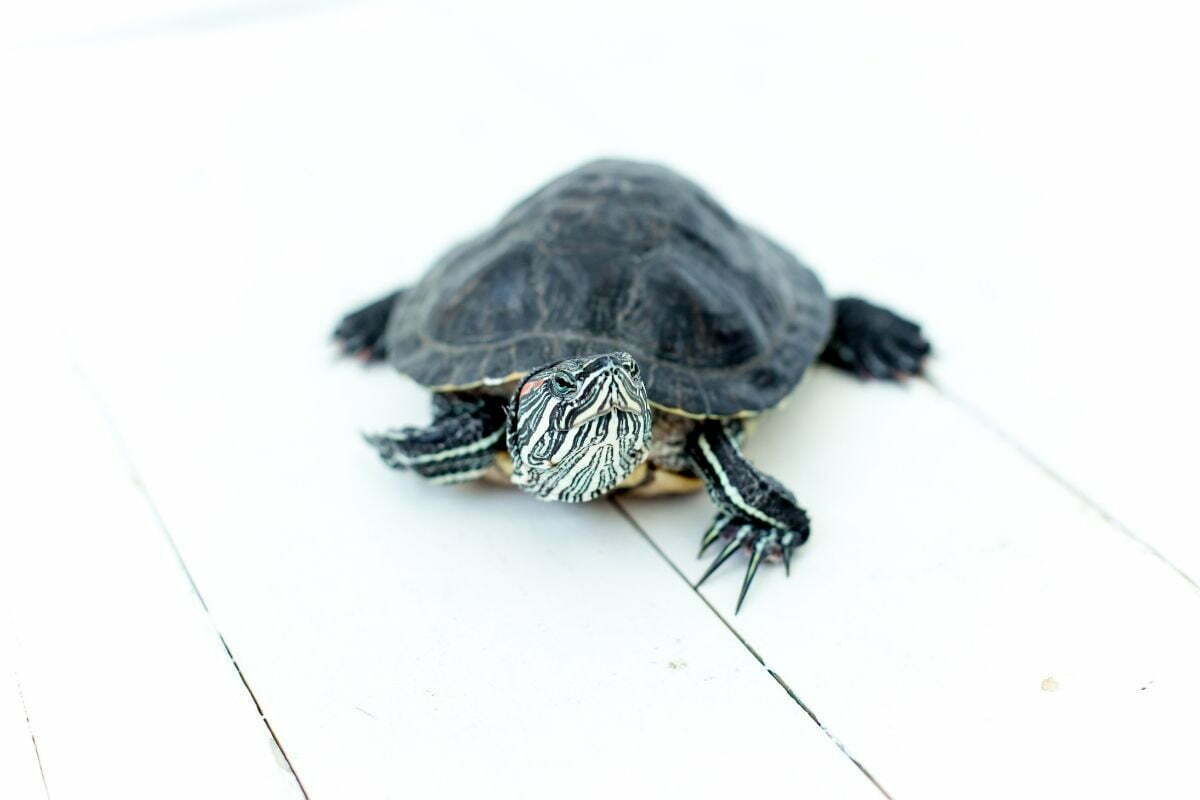
While there are many species of turtle, the most popular pet turtles are painted turtles, map turtles, red-eared sliders, box turtles, and snapping turtles. All of these turtles grow to different sizes and at different speeds.
Apart from heredity growth, there are a variety of factors that contribute to turtle overall growth and size. One of these is their diet. The more food you provide, the faster your turtle will grow. Similarly, feeding your turtle less will result in a slower development rate.
In this article, we will cover the average sizes of the turtles listed above, while also explaining some of the reasons why your pet turtle may not be growing as fast as you would expect.
Painted Turtle Sizes

As juveniles, painted turtles (scientific name Chrysemys picta) grow at a breakneck pace. As juveniles, these turtles grow at an average rate of around 1.2 cm (12.3 mm) every year.
After reaching sexual maturity around the age of ten, the growth rate would have dropped to 0.1 cm (1.2 mm) every year.
When these turtles hatch, the painted turtle will be just a few centimeters in length. By the time the turtle reaches the age of one, it should have reached a length of around 2 inches (5 cm). By the age of two, the shell would have grown to around 2.7 inches (7 cm) in length.
By the age of four, the painted turtle should achieve a length of roughly 3.1 inches (8cm), and by the age of five, approximately 3.1 inches (9cm).
Painted turtles achieve sexual maturity around the age of 10. The turtle’s shell would be around 4.7 inches (12 cm) in length at this age. Though the growth of the painted turtle slows right down after this period, they do keep growing a little longer.
Within the next 10 years, your painted turtle will grow about an inch more (3cm).
The final shell length of a typical painted turtle is 6 inches (15 cm). The length of their body will usually be around 4-10 inches long (10-25 cm).
Map Turtle Sizes
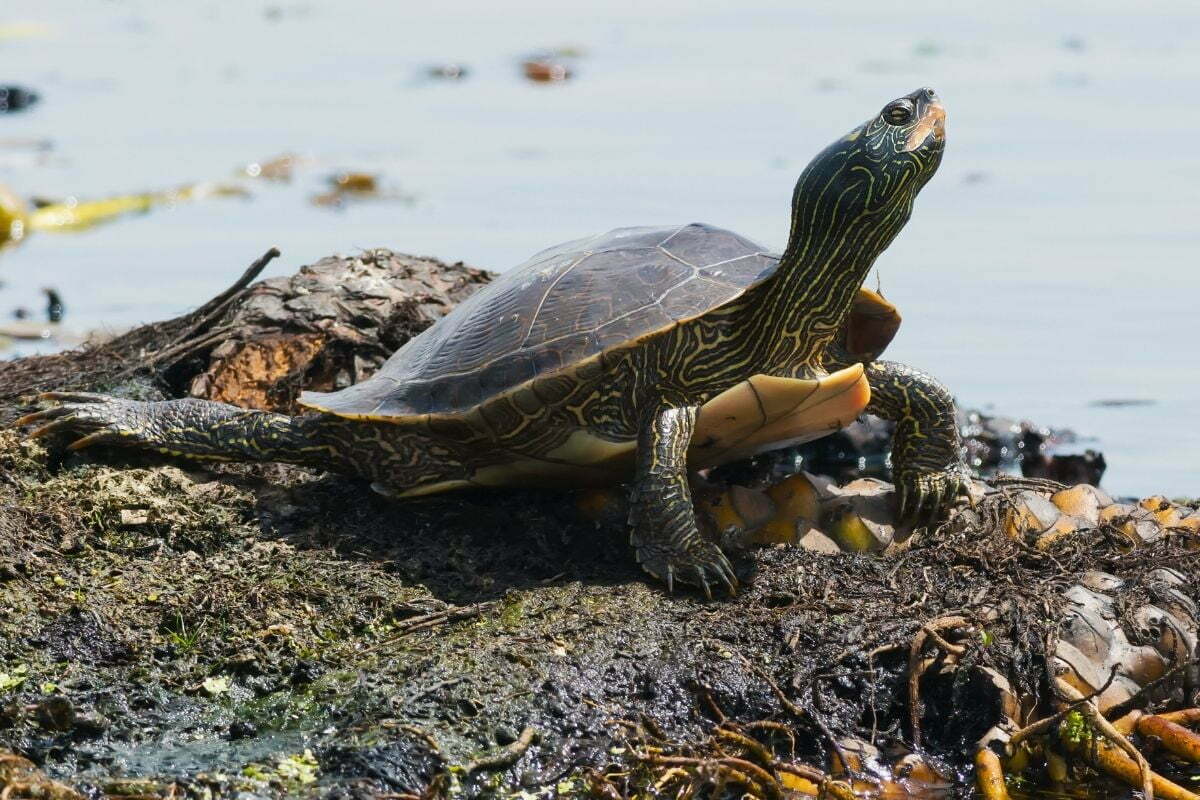
Turtles like the common map turtle (scientific name Graptemys geographica) usually are quite small. The size of your map turtle will depend on its gender.
A normal adult male can be around 4 inches long (10.16cm). Females, on the other hand, are significantly bigger, reaching an adult length of 7 – 10 inches (17.7 – 25.4cm).
Male map turtles hatch with a plastron length (the flat underside of the turtle’s shell) of around 1.1 inches (3 cm), making them bigger than females during this time. Females hatch with a plastron length of approximately 0.78 inches (2 cm).
At one year old, males attain a plastron length of around 1.6 inches (4.2 cm), while females reach a length of 1.7 inches (4.4 cm). Men’s plastron length will be roughly 2.3 inches (6 cm) by age 2, while girls’ plastron length will be approximately the same during this age as well.
When they are four years old, the male plastron should reach a length of 3 inches (7.5 cm), while the female plastron should reach a length of 3.8 inches (9.7 cm). Females should be much larger than male turtles at this age.
By the time the map turtle reaches the age of five, the male should be roughly 3 inches (8 cm) long, while the female should be approximately 4.3 inches (11 cm tall). Between the ages of 5 and 6, males should have reached sexual maturity.
Females mature much later at the age of 10 and grow to a length of around 7 – 8 inches (18 to 21 cm).
Red-Eared Slider Sizes
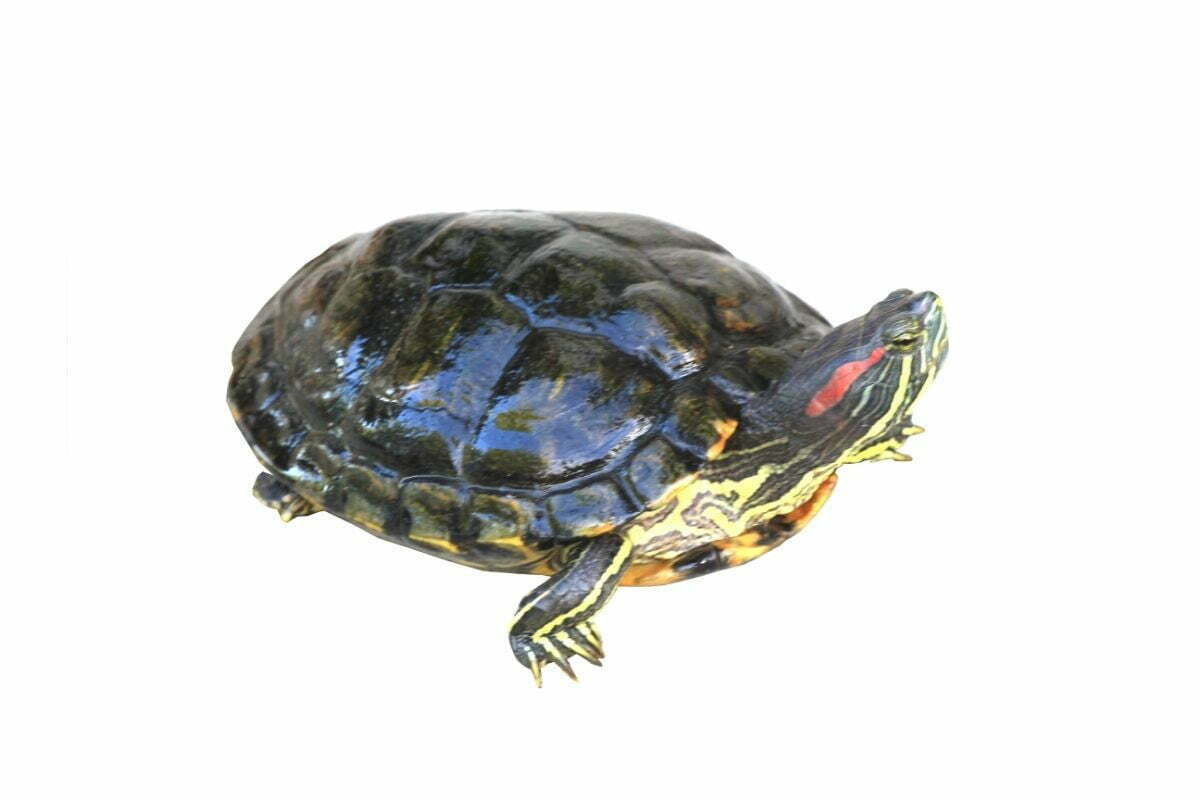
Red-eared sliders develop at the highest rate throughout their first couple of years of life. They should achieve a length of around 1.1 – 1.6 inches (3 – 4 cm) within the first year.
They can grow to a maximum length of 2.3 inches (6 cm) at the age of two. The red-eared slider should double this length within a year, and reach a length of 4 inches (10 cm) by the age of three.
By the time the slider reaches the age of four, it should have grown to around 4.5 inches in length (11.5 cm).
Male red-eared sliders attain breeding maturity when they grow to a length of 4 inches (10cm), while females are mature when they reach a length of 6 inches (15xm). Both males and females will usually reach these respective lengths when they are around 5-6 years old.
It takes around eight years for these turtles to fully grow. They typically end up being between 7-12 inches (18-to 30cm) long.
There can be some variation within these sizes though, with your turtle perhaps growing two inches above or below the average for the final length.
Box Turtle Sizes
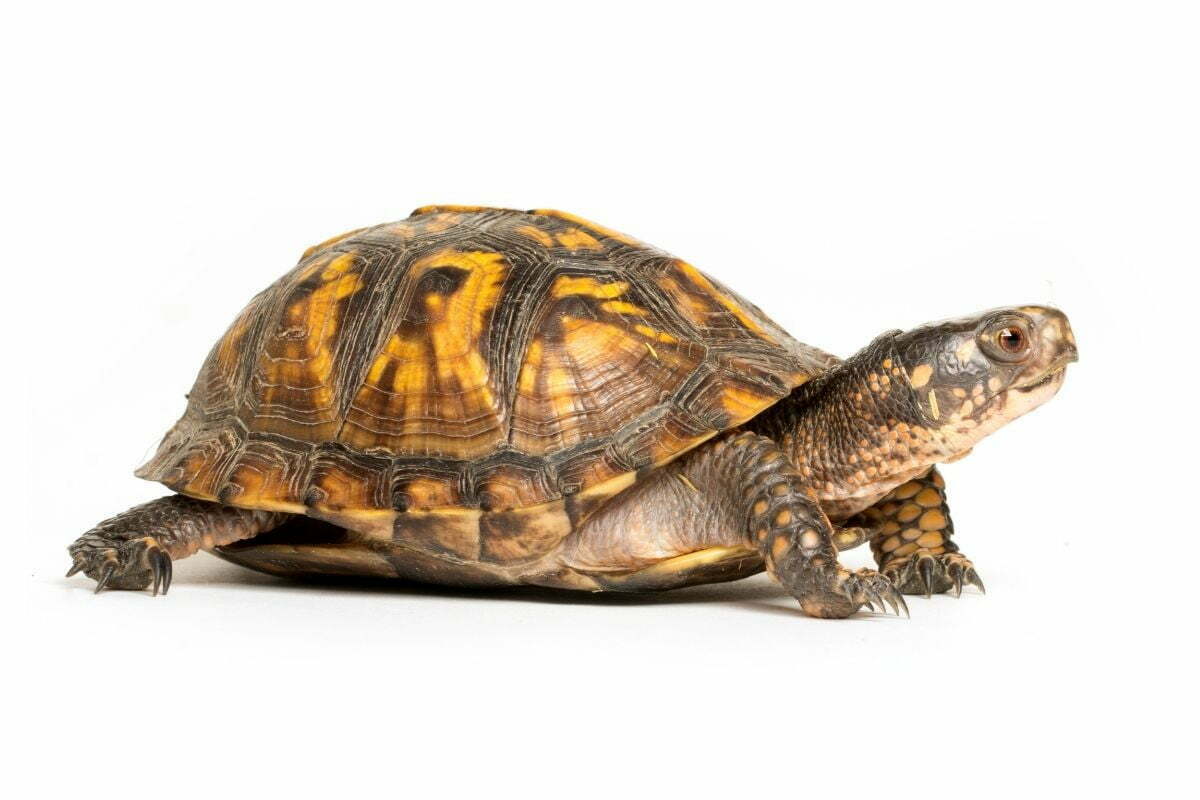
As with the other turtles, the common box turtle (scientific name Terrapene Carolina) develops the fastest during its juvenile stage.
As they age, their growth rate decreases. Throughout its early years, the box turtle will grow at a rate of around 1 cm (10 mm) every year between ages 0 and 5.
After this, their growth slows down slightly. Between 5-10 years old, you can expect your box turtle to grow around 0.8cm (8mm) every year.
Their growth once again slows down after they reach 10 years old. Between the ages of 10-15 years old, your turtle should grow at a rate of around 0.2 cm (2.5 mm) every year.
Hatchlings have a carapace (the top of the shell) that is around 1 inch (2.5 cm) in length. The turtle should continue to develop gradually over the next five years. By the age of five, the chelonian’s carapace should be around 3 inches (7.5 cm) in length.
This upward trend in growth is likely to continue for the next five years. By the age of 10, the box turtle’s carapace should measure around 4.8 inches (12.3 cm) in length.
From here, growth is significantly reduced, with the turtle adding just a few centimeters further throughout its life.
At maturity, between the ages of 7 and 10, the turtle’s carapace should measure between 5 – 6 inches (12.7 – 15 cm) in length.
Snapping Turtle Sizes
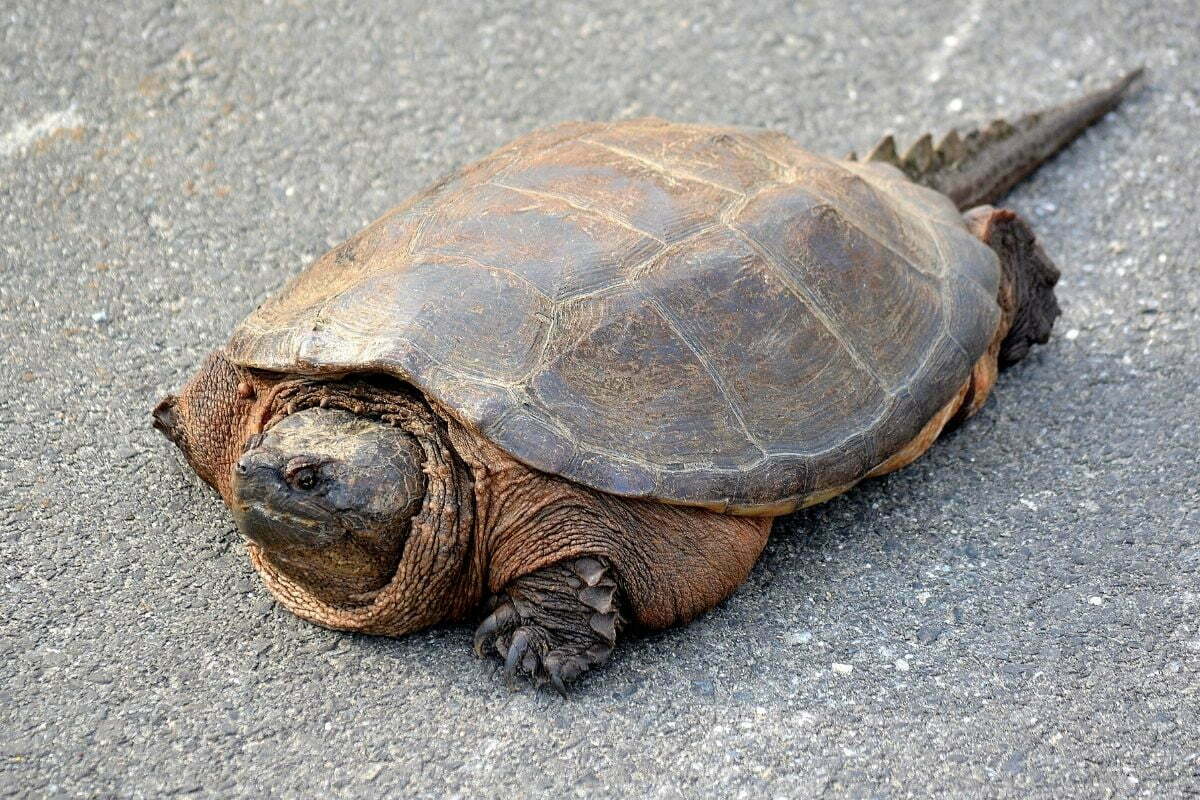
Surprisingly, snapping turtles are frequently kept as pets. These turtles consume food at an extremely fast rate. When maintained in captivity, they are prone to gluttony, which speeds up their growth and development.
Snapping turtles, like many other turtles, develop most rapidly during their juvenile years. Naturally, each snapping turtle grows at a distinct rate based on the amount of food that they have available to them.
The shell of the common snapping turtle expands to an average length of 5 – 6 inches (12 – 15 cm) within the first two years. After this, their growth slows right down. The snapping turtle’s shell will only grow 12 – 14 inches (30 – 35 cm) longer over the next 15 to 20 years.
Adult snapping turtles can reach a length of 19 inches (45 cm) and a weight of 86 lbs (40 kg).
What Factors Affect The Growth Of Turtles?
There are a few things that will have a big impact on how fast your pet turtle grows, and the final size of your turtle. Here are a few common factors you need to keep in mind to ensure that your turtle grows at the correct and healthy rate.
Their Environment
It is vital to maintain specific elements like a basking area, hiding spaces, an enclosed space, temperature control, good UV exposure, and the quantity and quality of the water to promote optimal growth.
It is necessary to supply the turtle with the appropriate amount of UV radiation for it to develop the right way and at the optimum rate.
As a result of a lack of ultraviolet B and ultraviolet A exposure, metabolic bone disease, and shell pyramiding can develop. This not only stunts the growth and development of the turtle, but it can also be very painful for them, and can sometimes lead to death.
When the turtle is healthy, it has a positive influence on its growth. Clean water is essential to this.
The quantity of enclosed space available is also quite important. An insufficient amount of living area might limit a turtle’s growth and development.
You can guarantee that the turtle grows at a steady rate by ensuring that it is healthy and free of stress.
Their Diet
A huge amount of emphasis can be placed on the importance of your turtle eating a nutritious diet. You must supply your turtle with the right amount of food for it to develop at the optimum rate.
You must also remember that you cannot feed the same meal to all of the turtles. The sort of food you provide your turtle should be dictated by the species. Per their food, turtles can be classified as carnivores, herbivorous, and omnivorous.
Before getting any species of turtle as a pet, you have to do a lot of research, but pay very close attention to the food that is suitable for your new pet.
The variations between what is suitable for each breed of turtle may be a lot bigger and more than you would expect.
For example, a box turtle needs around 60% of its diet to be protein-based. Painted turtles on the other hand only need around 30-40$ of their food to be protein, the rest can be made up of plants.
In addition to all of this, baby and younger turtles have a greater requirement for protein than adults do, and you will have to keep changing the diet of your turtle as it continues to grow and age.
As an example, a baby box turtle needs to have a diet that is 70-75% protein, with the rest of its diet made up of carbohydrates. As it gets older, it will require slightly less protein.
In addition, a consistent feeding schedule should be followed at all times by you and the turtle. While the majority of newborn turtles require feeding at least once a day, once they reach adulthood, most turtles only need to be fed once or twice a week.
Their Species
Different species of turtle develop at differing rates from one another. Also, within one species of turtle, there may be some slight differences in the growth speed and final size of the turtle.
There is the possibility that two turtles from the same species, who live in the same environment, are of the same sex, and on the same feeding schedule and diet will end up being two completely different sizes.
Every turtle, just as every human being, is a unique individual with a distinct personality of its own. In addition, the growth rates of different species differ significantly. As an example, a snapping would have grown to a length of 4.7 inches (12 cm) by the time it reached the age of two.
The difference between this and the shell length of a red-eared slider, who will only reach a shell length of 4.7 inches (12 cm) at the age of four, is substantially different.
Summary
Knowing the rate at which a turtle develops allows you to make better-educated judgments about the turtle’s future. For example, you will know that tank volume should be increased by at least 10 – 15 gallons for every inch the turtle grows.
Because of this, you can easily work out how quickly a turtle will outgrow its tank if you keep this in mind. Alternatively, when purchasing the turtle, you may choose a tank size depending on the turtle’s anticipated future length.
Additionally, the growth rate may be useful in calculating when the turtle will be mature enough to reproduce on its own.
The growth rates of turtles belonging to the same species can range from one another.
Your turtle’s growth rate may be slower or faster than the pace stated above as a result of how it is raised and kept, but turtles very rarely grow above their average sizes mentioned above.
